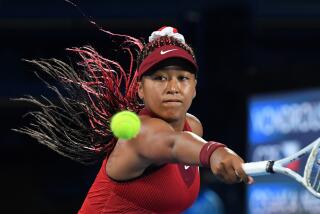TENNIS : It’s One Wild Selection Process
- Share via
NEW YORK — A long slide in the rankings and some possible U.S. Tennis Assn. politics helped put Alex O’Brien over on the practice courts here Wednesday, drilling hard for his second-round match in the U.S. Open. Second-round doubles, that is.
The name should be familiar. O’Brien is a 29-year-old Stanford graduate who has been around the men’s tennis tour for seven years, has made a nice living at something he loves to do and has some nice peaks in a career that, at the moment, is in a bit of a valley.
The peaks include winning the 1996 New Haven tournament, plus gaining three Grand Slam tournament finals in doubles--the 1996 and ’97 Australian with Canadian Sebastien Lareau and the 1995 U.S Open with Australian Sandon Stolle--and three appearances for the United States in the Davis Cup--in Brazil, England and in a loss against Australia at Boston in July.
At Boston, O’Brien teamed with Pete Sampras to get the only U.S. point, in a five-set victory over Mark Woodforde and Stolle, and, to date, that is O’Brien’s lead item on his career highlight film.
“That has to be my most memorable moment in tennis,” O’Brien said Wednesday. “It was a home tie, my first one. I’m representing my country and I’m playing with the greatest player ever to play the game.
“There was one moment, one point in the fifth set, when the crowd was so loud and the feeling so incredible that it was like I was walking on air. I’m not a big guy on thinking about history, or where things fit in the game for me, but I remember thinking that this was amazing, that this is why I play the game.”
Suffice to say that O’Brien does not play the game to be on the sidelines when the singles draw is posted for the U.S. Open, yet that is what happened. And while he is blaming nobody but himself--he was sought for this story, he didn’t do the seeking--his plight is an interesting study in USTA decision-making.
O’Brien, once as high as No. 30 in the world after his big 172-place gain in the rankings in 1996, is now No. 174. The U.S. Open main draw, with 128 spots available, cuts it off in the rankings around 104 for automatic berths. The rest of the spots are filled by 16 qualifiers from a pre-event tournament and eight wild cards. In the wild-card selections, decided by USTA officials, an obvious edge is given to American players.
This year’s wild-card selection was something of an eyebrow raiser.
Chosen on the men’s side were Bob Bryan of Camarillo, ranked No. 199; Kevin Kim of Fullerton, 240; Taylor Dent of Newport Beach, 283; Mashiska Washington of Delray Beach, Fla., 312; James Blake of Fairfield, Conn., 333; Phillip King of Long Beach, 690, and Jeff Morrison of Huntington, W.Va., and MaliVai Washington of Ponte Vedra Beach, Fla., both unranked.
Before the tournament began, MaliVai Washington, a Wimbledon finalist in ’96 and a player ranked as high as No. 11 before suffering an injury that has kept him out most of this year, pulled out because of a new injury. He was replaced by veteran Richey Reneberg of Atlanta, currently ranked No. 206.
O’Brien’s ranking as one of the Americans closest to the No. 104 cutoff and his Davis Cup service would have seemed to make him an easy choice for a wild-card spot. When no call was forthcoming from the USTA, O’Brien entered the qualifying tournament and lost in the first round to top-seeded Ivan Ljubicic of Croatia, despite holding a 4-2 lead in the third set.
“No excuses. My fault,” O’Brien said. “I should have qualified.”
But a closer look at the wild-card choices of the USTA does give one pause, not only on behalf of O’Brien, but others such as No. 163 Geoff Grant.
MaliVai Washington is an obvious choice, if healthy. Blake, Bryan, Dent and King are explained away as part of the USTA’s ongoing effort to get the most out of promising newcomers. Kim has been one of those newcomers since he won the national boys’ 18 title in ‘96, and Morrison automatically gets a spot by virtue of his NCAA title for Florida this spring.
Mashiska Washington, MaliVai’s brother, who, at 25, does not seem to be a part of any youth movement, turned pro in 1995 and has a 1-5 record in main tour events since then.
The choice of Mashiska took on additional controversial overtones when one of the women’s wild cards went to Mashona Washington, 23, MaliVai and Mashiska’s sister, who entered the U.S. Open ranked No. 159 among the women. Mashona has made it to the second round of two Women’s Tennis Assn. events this year.
Both Mashiska and Mashona lost in the first round here, Mashiska in four sets and Mashona in three. After his loss, Mashiska, when asked about the wild-card controversy, said, “I think all Americans should have an opportunity to play in America’s tournament.”
All this was against the background of a letter sent out last season by William Washington, who is black and the father of the tennis-playing Washington family. The letter went to many people in tennis, including members of the media, and it accused the USTA of discrimination in its player development and team selection. Last Friday, William Washington filed a complaint in U.S. District court here against the USTA, charging many of the same things he did in his letter.
Jay Snyder, U.S. Open tournament director, denied, despite the fact that three of the 16 wild cards awarded went to the Washington family, that political correctness had anything to do with the choices. Those choices were made in a meeting of USTA coaches, officials, player development personnel and Davis Cup captain Tom Gullikson.
“After we got done with the selections,” Snyder said, “I was the one who asked the group if it had occurred to anybody that three of our wild cards went to one family. And the truth was, it hadn’t. We had done it piece by piece and each had earned the spot separately.”
Snyder said that the USTA stressed player development and not marquee names, and said that Reneberg was selected over O’Brien when MaliVai Washington pulled out because Reneberg had only received one wild card into the U.S. Open over the years and O’Brien had received four. Had one more spot come open, O’Brien would have gotten it, followed by Grant, Snyder said.
“Nobody in our group was striving for political correctness in this,” Snyder said.
For the moment, O’Brien is mostly striving for excellence in the doubles draw, where he and Lareau are seeded No. 11 and won in the first round Tuesday.
“Doubles can be a good life, and a good living,” O’Brien said. “But I still think I can get back to No. 30 in singles. I also have a dream to play in the Olympics. I’m not sure exactly how that works, but to get one of the doubles spots would be an unbelievable experience.”
How it works is much like how the Davis Cup team and U.S. Open wild cards are chosen: A good ranking, some good luck and, just maybe, a dash of politics.
More to Read
Go beyond the scoreboard
Get the latest on L.A.'s teams in the daily Sports Report newsletter.
You may occasionally receive promotional content from the Los Angeles Times.











